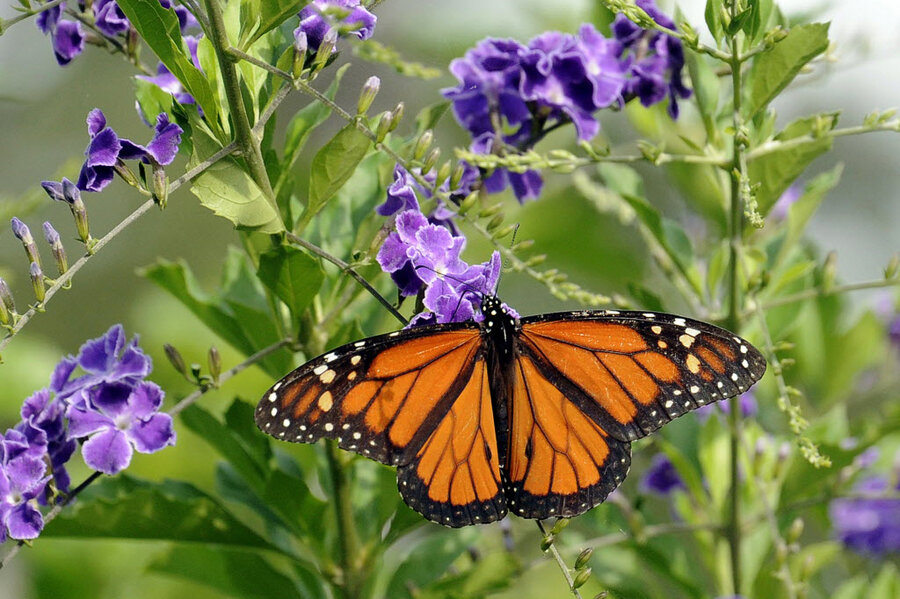How Obama's 'butterfly highway' paves way to save embattled monarchs
Loading...
The Obama administration is hatching a plan to establish a 1,500-mile butterfly corridor along US Interstate 35 connecting Minnesota and Texas to protect the monarch butterfly.
The majestic North American monarch is well known for both its trademark orange and black stripes as well as its epic annual migration from Canada to Mexico. The number of monarchs reaching the wintering grounds in southern Mexico has declined by 90 percent in the past 20 years. The losses have been so pronounced that the US Fish and Wildlife Service is considering listing the iconic butterfly as an endangered species.
The size of monarch populations is measured in the oyamel fir forests, north of Mexico City, where the butterflies spend the winter swathing trees in a flutter of orange and black. Over the past few years, the area covered by monarchs equated to between two and three football fields, just a fraction of the 15 football fields seen during healthy years.
Weighing just a fraction of a gram each, these delicate creatures need all the nourishment they can get during their 2,000-mile migration to and from Mexico. Loss of nectar-producing plants and the milkweed along their path has contributed heavily to the butterfly’s decline. Without milkweed, monarch butterflies cannot lay their eggs, and monarch caterpillars lose their only source of food.
That’s where President Obama’s butterfly corridor comes in.
Interstate-35 bisects the nation along one of the monarchs' natural migration pathways, making the roadway an ideal location to establish a so-called butterfly highway, says ecologist Scott Black, executive director of the nonprofit Xerces Society for Invertebrate Conservation based in Portland, Ore.
The Xerces Society has already been working with the Federal Highway Administration to develop best practices for roadside management, including incorporation of flowering plants and milkweed and adapting mowing schedules to migration patterns. Such efforts will undoubtedly be employed along the I-35 roadside, but the president’s plan is much broader than that.
“The idea is to use it as this iconic pathway to work with schools, farmers, ranchers, and park districts to improve habitats for 50 to 100 miles on either side of the I-35 corridor,” Dr. Black says.
Habitat loss has been particularly prominent in the Midwest since the development in the 1990s of corn and soybean crops that have been genetically engineered to be resistant to a popular herbicide, Black says.
“With the advent of “Roundup Ready” – or glyphosate-resistant – corn and soybeans [farmers] have been able to effectively remove that milkweed from 100 million acres of land,” Dr. Black says.
Replacing that lost habitat is likely to become more important as other stressors relating to climate change bear down on butterfly populations.
So far, there is no direct evidence that climate change has impacted monarchs, because the link between specific weather variations and climate change is still somewhat theoretical, Black says. However, there is evidence that the drought in Texas has impacted sub-populations in recent years, and climate models suggest that future changes in climate could one day render the oyamel forests inhospitable.
Developing robust migratory habitats in the United States could make or break the monarch’s ability to adapt to coming changes, Black says.
“If habitat quality is really good, the monarchs will be able to do the best they can under whatever circumstances they are faced with,” he says.
“The neat thing about monarch and pollinator conservation is that you can do it anywhere,” Black says. “You can take a park or a school yard, put in flowering plants and milkweed, and make sure to keep out herbicides. Everybody can take action.”
Conservation biologists hope that the buzz about the butterfly highway will help inspire citizens all over the United States to pitch into ongoing efforts to support the majestic butterflies, says Eva Lewandowski of the Monarch Lab at the University of Minnesota in St. Paul. (The US has been engaged in multinational efforts to preserve monarch migratory and wintering habitats in the US, Canada, and Mexico for 20 years.)
In addition to planting flowering plants and milkweed, ordinary citizen scientists also can participate in monitoring efforts.
“The monarchs’ range spreads so far throughout North America that there just aren’t enough scientists to fully monitor them. We need members of the public to help,” Ms. Lewandowski says.
Developing a robust picture of where monarchs are and are not thriving can provide conservationists with important clues about the general health of ecosystems.
“We think monarchs are really important because where monarchs are, other insects and species can thrive,” Lewandowski says.
She recommends going to the Monarch Joint Venture website to learn about how to aid in monitoring and habitat restoration efforts.
“We absolutely believe the average person can make a difference provided there are enough people out there doing it.”
[Editor's note: This article has been updated to clarify the range of miles on either side if Interstate 35 included in the butterfly corridor. It is 50 to 100 miles. The name of the Xerces Society for Invertebrate Conservation has also been corrected.]








